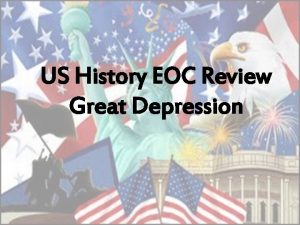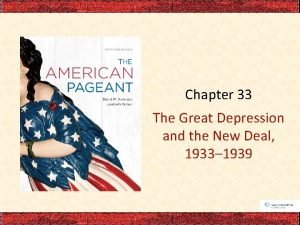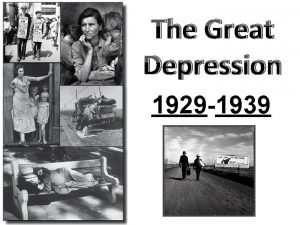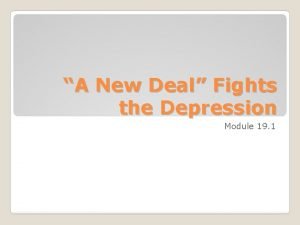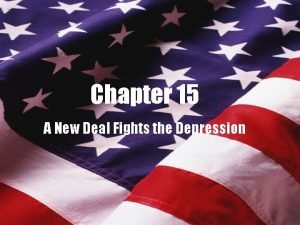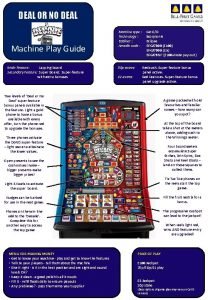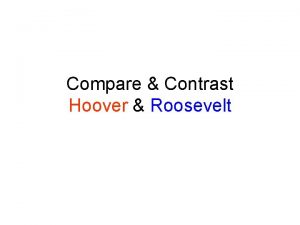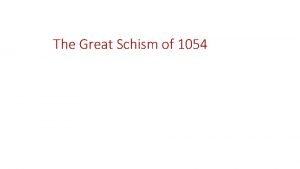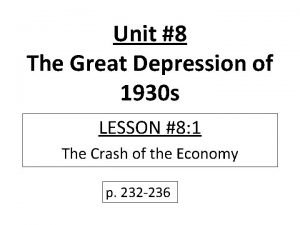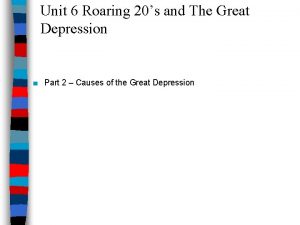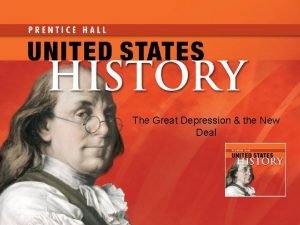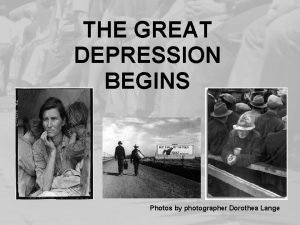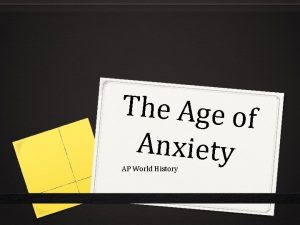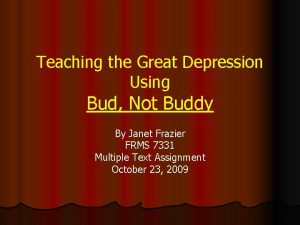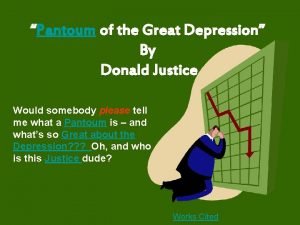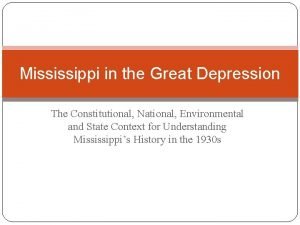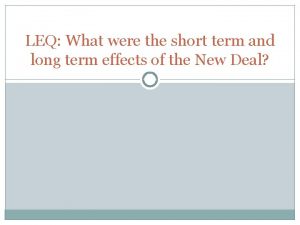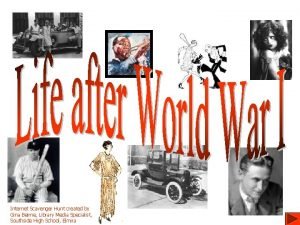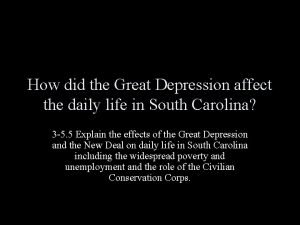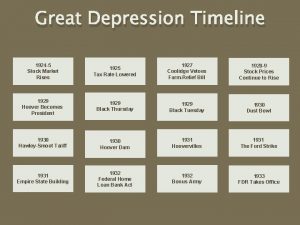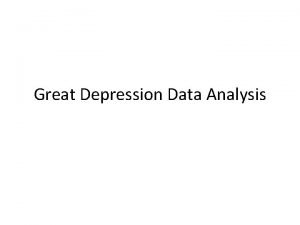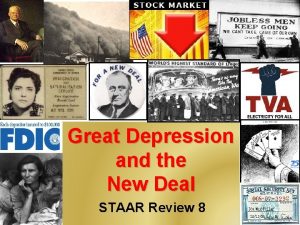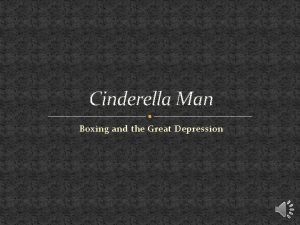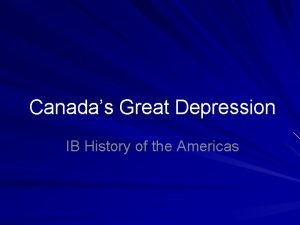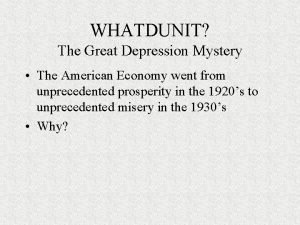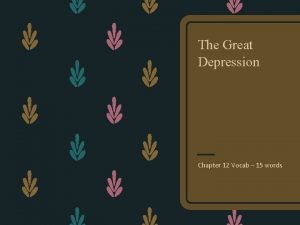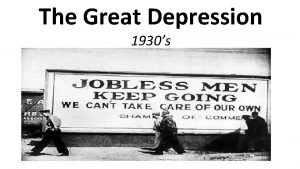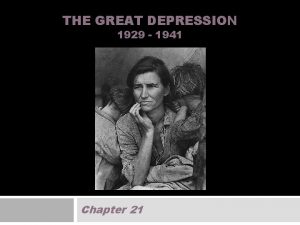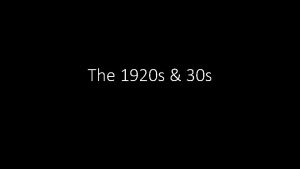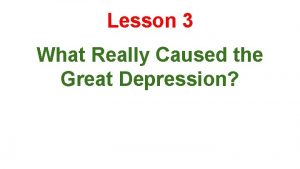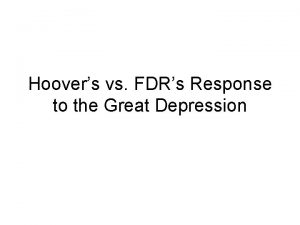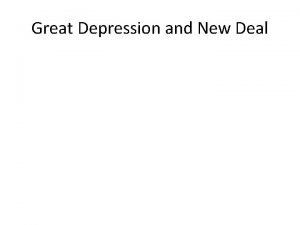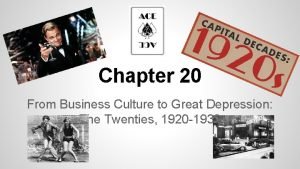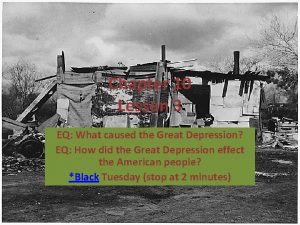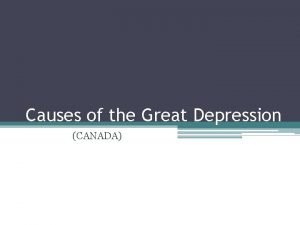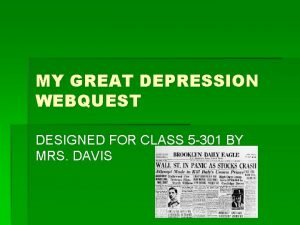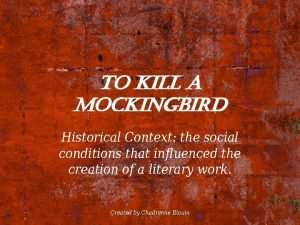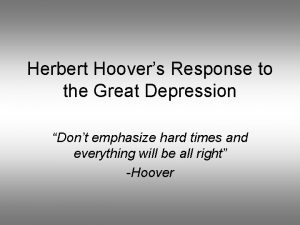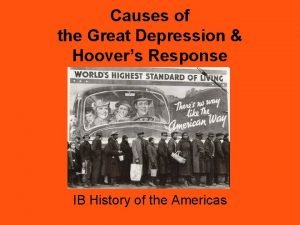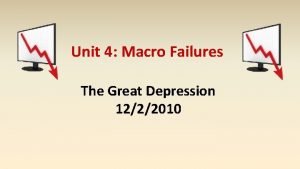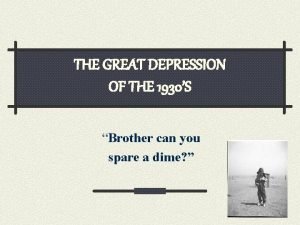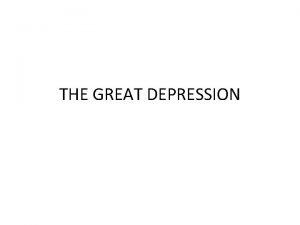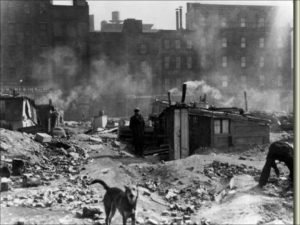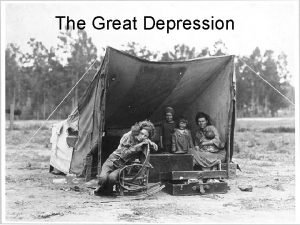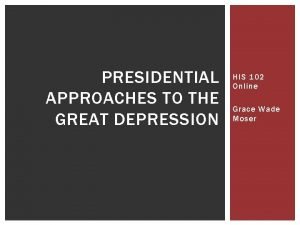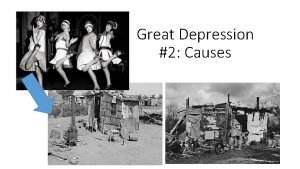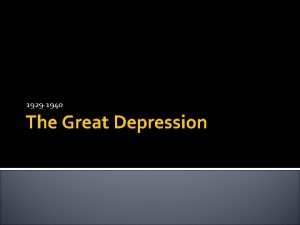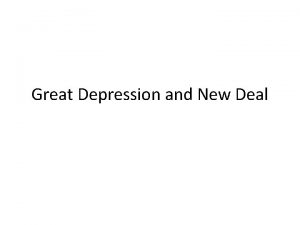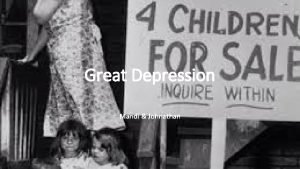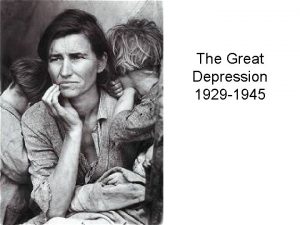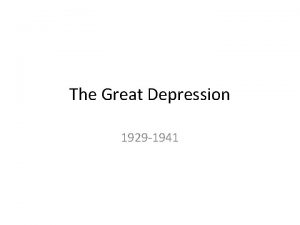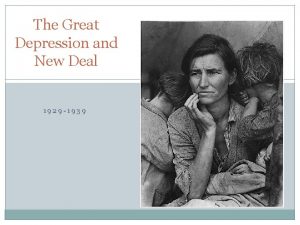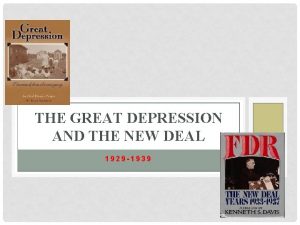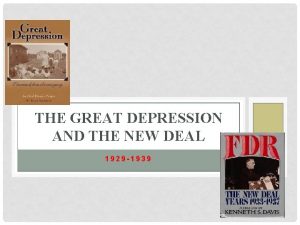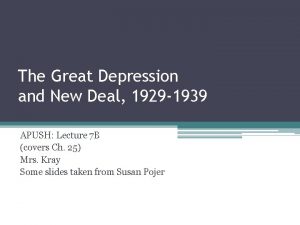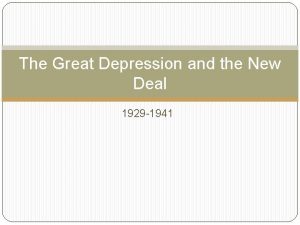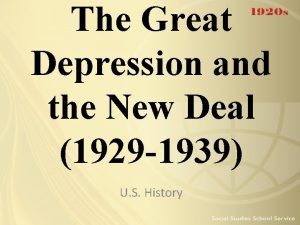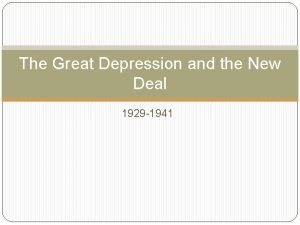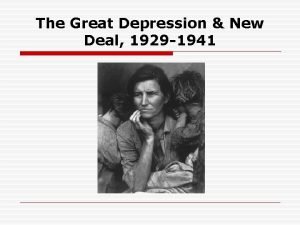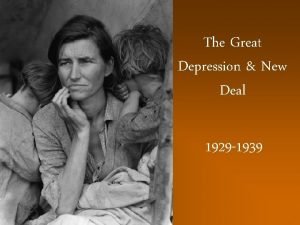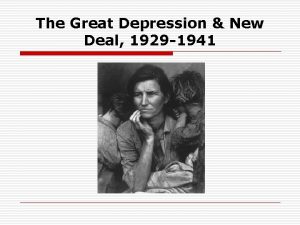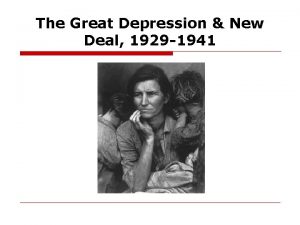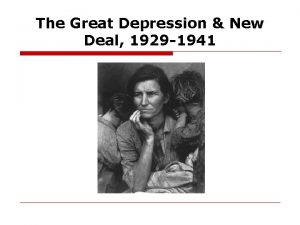The Great Depression and New Deal 1929 1940



































































- Slides: 67

The Great Depression and New Deal, 1929– 1940 The Great Depression has a major impact on American society. President Franklin Roosevelt ends the economic downturn and changes the role of U. S. government. "Joad Family Applying for Relief" (named for family in Steinbeck’s The Grapes of Wrath)—migrant farmers seek government aid. Photo (1938), Horace Bristol. NEXT

The Great Depression and New Deal, 1929– 1940 SECTION 1 Hoover and the Crash SECTION 2 Roosevelt and the New Deal SECTION 3 Life During the Depression SECTION 4 The Effects of the New Deal NEXT

Section 1 Hoover and the Crash After the stock market crash of 1929, the U. S. economy sinks into the worst depression in its history. NEXT

SECTION 1 Hoover and the Crash Problems in the Economy • Herbert Hoover elected president (1928) • Despite overall prosperity, some industries are in trouble • 71 percent of U. S. families earn below amount needed for decent living • Industries produce more goods, people cannot afford to buy enough • Unsold goods pile up in warehouses • Many investors buy on speculation—buy, sell stocks, make quick profit Continued. . . NEXT


SECTION 1 continued Problems in the Economy • Investors begin buying on margin: - pay small part of stock’s price as down payment, borrow the rest - sell stock, repay loan, keep profit • Works if prices rise, if prices fall unable to repay loans NEXT

SECTION 1 The Crash and the Great Depression • Stock prices drop sharply, people try selling thousands of shares • Heavy selling drives prices down more, scares off buyers • On October 29, 1929, Black Tuesday, investors: - sell 16. 4 million shares at prices lower than previous month • Stock market prices plunge—Crash of 1929 Continued. . . NEXT

Telephone operator connected to New York, writes share values on blackboard, as club members eye market fluctuations after financial crash.

SECTION 1 continued The Crash and the Great Depression • Many people unable to pay bank loans, banks run short of cash • People demand their money from banks, many banks run short, close • People buy less goods, cause thousands of businesses to go bankrupt • Businesses fire workers, unemployment grows to 25% by 1933 • Great Depression—severe economic depression, 1929 to WW II, global NEXT



Farm prices were low; farmers suffered poverty. Although some Americans were rich, 71 percent of Americans did not earn enough to live decently; some had no jobs.

Railroads, textile mills, and mines were in trouble; other industries produced more goods than the public could buy. Since they could not sell all their products, they had trouble earning enough income to stay open. People who wanted consumer goods they couldn’t afford went into debt to buy them. Consumer debt grew higher than people could repay. Prices rose; investors bought on speculation and engaged in buying on margin. If stock prices fell, they would be unable to repay debts.

SECTION 1 Hoover Acts Conservatively • President Hoover cuts government spending, raises taxes which: - pulls money out of economy, makes depression worse • Refuses to support government relief—aide to the poor • Asks for increase in charitable work, not enough to help everyone • Supports public works projects: - government-funded projects to build public resources, creates jobs NEXT

SECTION 1 Hoover Loses to Roosevelt • Congress promises World War I veterans bonuses due in the 1940 s • Thousands of WW I vets form the Bonus Army: - sets up camp around Washington D. C. - asks Congress to pass law granting early payment of bonuses "Bonus Army"— unemployed World War I veterans Continued. . . NEXT

SECTION 1 continued Hoover Loses to Roosevelt • President Hoover, Senate votes down bill for bonus payment • U. S. troops use tear gas, remove remaining vets, families, kill 1 vet • Attack turns Americans angrily against Hoover • Franklin Delano Roosevelt wins presidential election (1932) NEXT

He thought it might make the economy worse; he thought people would grow too dependent on the government if the government paid them relief. He proposed a quality he called “rugged individualism, ” and he urged volunteer efforts. He thought charities and churches should care for those in need. He did not support their request for early payment of their wartime bonus but instead backed the Senate when it voted against the bill.

C. Recognizing Effects, explain how most Americans responded to Hoover’s policies and actions. People grew bitter and blamed Hoover for their troubles; the public turned against him and elected his Democratic opponent, Franklin Delano Roosevelt, in 1932.

Section 2 Roosevelt and the New Deal After becoming president, Franklin D. Roosevelt takes many actions to fight the Great Depression. NEXT

SECTION 2 Roosevelt and the New Deal Roosevelt Takes Charge • Democrat Franklin Delano Roosevelt (FDR) inaugurated on March 4, 1933 • Gives Americans hope, willing to try new ideas, change government • Takes 3 steps to build public confidence: - declares “bank holiday”—temporary shutdown of banks - promises that only banks in good shape will reopen - fireside chats—radio talks, FDR explains policies in friendly way NEXT

SECTION 2 The Hundred Days • FDR pledges New Deal—programs to fight Depression • Congress passes bills sent by FDR in Hundred Days session • Laws passed have 3 goals: - relief for the hungry - recovery for agriculture and industry - reforms to change the way the economy works NEXT


temporary shutdown of all banks; only those banks in good shape would reopen Radio talks in which FDR explained his policies in a warm, friendly way programs to fight the Depression; goals were relief, recovery, and reform

SECTION 2 Responses to the New Deal • Some conservatives oppose New Deal, growth of U. S. government • Question payment of new programs, fear U. S. moving toward socialism • Senator Huey Long wants redistribution of wealth in U. S. to gain power • On radio, priest blames Jews for bad economy: - Catholic church stops priest’s broadcasts • Another critic proposes pension, Americans over 60, figures disputed • Voters support New Deal, elect more Democrats to Congress (1934) NEXT

SECTION 2 The Second New Deal • Congress passes Social Security Act (1935): - workers, employers make payments into a special fund - they draw a pension from fund after they retire - also helps laid-off, disabled workers, needy families, dependents • Social Security is part of programs passed in 1935 —Second New Deal • Working class, African Americans support FDR, wins reelection (1936) NEXT


thought it went too far; opposed growth of federal government; feared new taxes and threat of socialism thought it didn’t go far enough; wanted redistribution of wealth thought it didn’t go far enough; wanted to change economy to help poor thought it didn’t go far enough; wanted to give $200 a month to every American over the age of 60

SECTION 2 Roosevelt Fights the Supreme Court • Most of 9 justices of Supreme Court do not support FDR’s programs • Strike down laws they believe gives federal government too much power • FDR wants bill allowing him to add 6 justices, gain New Deal support • Democrats, Republicans criticize Court-packing bill, bill voted down • Retirements, deaths allow FDR to name 5 liberal justices NEXT




SECTION 2 The New Deal Slows Down • Opposition to FDR grows after Court-packing attempt • Economy gets worse in 1937, many blame FDR • Critics attack FDR’s deficit spending which involves: - using borrowed money to fund government programs • FDR himself doubts deficit spending policy NEXT

Social Security Act: a law that set up a system in which workers and employers made payments into a special fund, from which they would draw a pension Second New Deal: a set of programs passed in 1935, including Social Security Act, the Wagner Act, and others “court-packing” bill: a bill, proposed by FDR, that would allow him to add up to six justices to the Supreme Court (in an attempt to gain a majority who would favor his programs) deficit spending: using borrowed money to pay for government programs

Section 3 Life During the Depression, most Americans know great hardship. NEXT

SECTION 3 Life During the Depression The Dust Bowl Destroys Lives • In early 1930 s, drought hits Great Plains, winds cause dust storms • Dust damages farms across 150, 000 square-mile region—Dust Bowl • Ruined farmers, families migrate to find work, many go to California • Newcomers overcrowd California, many from Oklahoma, called “Okies” NEXT


Dust storm in Spearman, Texas, April 14, 1935.

SECTION 3 Living Through Hard Times • In 1936, 9 million people in U. S. are unemployed • Bread lines offer food to hungry, many people lose homes • Homeless often live in makeshift shelters, under bridges • Boys often leave school to work, girls stay home to look after kids • Many teenagers run away from home, avoid burdening their family • Women often give up jobs to men, work at lowpaying jobs, servants NEXT

Charity workers serve soup to unemployed men at lower level of Wacker Drive in Chicago, Illinois (November 4, 1930).

They saw their farms ruined by drought and dust storms; dust buried crops; farmers and their families became migrants in search of work but found few jobs in the Pacific-Coast states. Many people lost jobs and could not buy food for their families; thousands stood in bread lines; some families lost homes and lived in shacks or cars; children dropped out of school and tried to find jobs; fathers felt a loss of status and argued with families; women were pressured to give up jobs, but many still worked.

Explain the importance of each of these terms and names. Dust Bowl A 150, 000 -square-mile region in parts of Kansas, Oklahoma, Texas, Colorado, and New Mexico, that experienced drought and dust storms that damaged farms and crops

SECTION 3 Artists Portray the Struggle • Writers James Agee, Walker Evans depict harsh lives of tenant farmers • John Steinbeck’s novel The Grapes of Wrath (1939) depicts migrant Okies • Black writer Richard Wright shows racism in novel Native Son (1940) • Photographers, including Dorothea Lange, capture Depression suffering NEXT

Dorothea Lange

SECTION 3 Women in the New Deal • First lady Eleanor Roosevelt helps poor Americans • Visits coal mines, work camps, hospitals, reports to FDR • Holds press conferences with women reporters: - introduces women who run New Deal programs • Frances Perkins named secretary of labor, 1 st female cabinet officer • Supports minimum wage, limit on child employment, unemployment laws NEXT

First Lady Eleanor Roosevelt (left) dressed as a miner aboard a coal train bound for Willow Grove Mine in Bellaire, Ohio (1935).

They wrote books and took photographs that portrayed the hard times. Women were pressured to give up jobs, but many still worked; more women held jobs in FDR’s administration than ever before.

SECTION 3 Minorities and the Depression • FDR has several African Americans in government positions • FDR fails to back civil rights laws, afraid of Southern opposition • Mexican Americans find few jobs, many do not benefit from New Deal • In 1930 s, immigration from Mexico declines, many Mexicans leave U. S. • Some Mexican-American U. S. citizens forced to leave U. S. • Native Americans receive arts support, some reservation land restored NEXT

SECTION 3 Unions Gain Strength • Labor union Congress of Industrial Organizations (CIO) open to: - women - minorities - unskilled workers • Labor movement uses sit-down strike: - instead of walking off jobs, workers remain idle inside plant - prevents factory owners from using strikebreakers • Wagner Act (1935) gives unions more negotiation power • Union membership increases 2. 7 million (1933) to 7 million (1937) NEXT


FDR included more minorities in government than before; he didn’t support an anti-lynching bill; even so, African Americans supported FDR because he tried to help the poor. Mexican Americans had trouble finding jobs; they received some aid from New Deal but not as much as other groups; some were deported to Mexico. Native Americans had some lands restored to their ownership; the Indian Crafts and Arts Board was created. The Wagner Act gave unions the ability to negotiate; a new labor organization, the CIO, was formed; unions used an effective new tactic, the sit-down strike; union membership grew.

B. Finding Main Ideas Use the back of this page to explain the importance of each of these terms and names. Congress of Industrial Organizations (CIO) sit-down strike Congress of Industrial Organizations (CIO): a labor organization that broke from the AFL in 1938 and was open to unskilled workers and more open to women and African Americans than the AFL sit-down strike: a bargaining tactic in which striking workers remain idle inside a plant so that the owner cannot hire strikebreakers to continue the work

Section 4 The Effects of the New Deal The Depression and the New Deal have many long-term effects on U. S. government and society. NEXT

SECTION 4 The Effects of the New Deal Lasting Effects of the Depression • Depression causes many to fear losing money, property again • Makes many feel money is very important, some feel system is lousy • New Deal does not end Depression • U. S. involvement in World War II makes economy grow again • New Deal forever changes the U. S. government NEXT


SECTION 4 A Larger Role for Government • FDR increases the president’s power • Does not abuse power, helps restore Americans’ faith in democracy • Expands role of federal government • Government runs programs for people’s welfare • FDR uses deficit spending to fund New Deal, pay for the war NEXT

Recognizing Effects As you read this section, use the chart below to record how the Great Depression and the New Deal changed individuals and the federal government. feared that the Depression would happen again; felt they had survived a terrible battle; worried that they would lose money and property again; either thought money was most important or decided to try to change the system president increased power and became more of an initiator of bills; federal government took over care-taking responsibilities previously part of local or state governments; more commonly used deficit spending

SECTION 4 New Deal Programs Today • New Deal programs help Americans today in the following ways: - a national pension system - oversight of labor practices - agricultural price supports - protection for savings - regulation of stock market by Securities and Exchange Commission NEXT

The floor of the New York Stock Exchange

SECTION 4 An Ongoing Political Debate • Democrats, Republicans still argue about: - federal, local government roles in various programs • Democrats more likely liberal, Republicans more likely conservative • liberal—favors government action to bring about reform • conservative—fewer government controls, individual economic freedom • Social Security in trouble but still exists today NEXT

Finding Main Ideas In the chart below, record the answers to the following questions about the legacy of the New Deal today. The Social Security system pays out pensions; it is so popular that both political parties want to save it. The FDIC replaces the deposits that individuals had in the bank, up to $100, 000. It watches the stock market and makes sure that companies follow fair practices for trading stocks.

A conservative wants fewer government controls and more individual freedom in economic affairs; a liberal wants the government to take action to reform society and the economy.

Didn’t interfere in economy; rugged individualism; encouraged charity; limited, late relief efforts Tried new ideas fireside chats New Deal Second New Deal Rejected Hoover and supported FDR; turned to bread lines; recorded hard times in art; developed fear of the future

Reflection Which of President Ho over’s responses to th e Depression do you thin k was the least succes sful? lack of government interf erence in the economy; “rugged individualism”

Reflection Judging from Pre sident Roosevelt ’s responses to th Depression, wha e t do you think we re his strengths a nd weaknesses as p resident? Strengths—tried n ew ideas; used pro blem-solving skills; communicat ed to the public; p ersuaded Congress to take a ction; handled a na tional crisis effectively. Weakn esses—tried to bec ome too powerful; made th e government too large and too powerful.

Reflection Which citizens’ r esponse to the D epression was the most creative ? recording hard times in a rt

This is the end of the chapter presentation of lecture notes. Click the HOME or EXIT button. NEXT

Print Slide Show 1. On the File menu, select Print 2. In the pop-up menu, select Microsoft Power. Point If the dialog box does not include this pop-up, continue to step 4 3. In the Print what box, choose the presentation format you want to print: slides, notes, handouts, or outline 4. Click the Print button to print the Power. Point presentation Print Text Version 1. Click the Print Text button below; a text file will open in Adobe Acrobat 2. On the File menu, select Print 3. Click the Print button to print the entire document, or select the pages you want to print Print Text BACK
 Aaa new deal
Aaa new deal What is the main idea of this cartoon?
What is the main idea of this cartoon? Chapter 33 the great depression and the new deal
Chapter 33 the great depression and the new deal Black tuesday great depression
Black tuesday great depression Political cartoon stock market crash 1929
Political cartoon stock market crash 1929 A new deal fights the depression
A new deal fights the depression Soil conservation and domestic allotment act
Soil conservation and domestic allotment act A great deal vs a great many
A great deal vs a great many Deal or no deal machine
Deal or no deal machine Asset deal vs share deal
Asset deal vs share deal Stock market crash 1942
Stock market crash 1942 Compare and contrast fdr and hoover
Compare and contrast fdr and hoover Hardship and suffering during the depression
Hardship and suffering during the depression Pros and cons of the great depression
Pros and cons of the great depression Dust bowl migration map
Dust bowl migration map 1000 species of finch have been identified
1000 species of finch have been identified What was the deal breaker in the great schism
What was the deal breaker in the great schism Rarig great depression
Rarig great depression Great depression
Great depression The ingenious quarterback
The ingenious quarterback Foreclosure great depression
Foreclosure great depression Five effects of the great depression
Five effects of the great depression Five effects of the great depression
Five effects of the great depression How did the great depression impact the world
How did the great depression impact the world Great depression ap world history definition
Great depression ap world history definition Bud not buddy
Bud not buddy Donald justice pantoum of the great depression
Donald justice pantoum of the great depression The great depression summary
The great depression summary Cpi during the great depression
Cpi during the great depression Okies great depression
Okies great depression The great depression leq
The great depression leq Roaring twenties scavenger hunt answers
Roaring twenties scavenger hunt answers How did the great depression affect south carolina
How did the great depression affect south carolina Great depression timeline
Great depression timeline Great depression causes
Great depression causes Mexican repatriation apush
Mexican repatriation apush Cinderella man great depression
Cinderella man great depression Birth rate during the great depression
Birth rate during the great depression Overspeculation great depression
Overspeculation great depression Great depression vocab
Great depression vocab Great depression vocabulary words
Great depression vocabulary words Poverty during the great depression
Poverty during the great depression Http://www.history.com/topics/great-depression
Http://www.history.com/topics/great-depression Hawley-smoot tariff great depression
Hawley-smoot tariff great depression Great depression budget activity
Great depression budget activity Fdrs response to the great depression
Fdrs response to the great depression Hoovervilles great depression
Hoovervilles great depression Laissez faire great depression
Laissez faire great depression New woman
New woman Great depression acrostic
Great depression acrostic Hoovervilles great depression
Hoovervilles great depression Great depression political cartoons
Great depression political cartoons Great depression vocabulary jeopardy
Great depression vocabulary jeopardy Chapter 22 the great depression begins
Chapter 22 the great depression begins Great depression
Great depression Great depression webquest
Great depression webquest Social context of to kill a mockingbird
Social context of to kill a mockingbird Hoovers response
Hoovers response Great depression
Great depression What was hoover's response to the great depression
What was hoover's response to the great depression Great depression
Great depression Great depression
Great depression Dust bowl map activity
Dust bowl map activity High tariffs great depression
High tariffs great depression Great depression photographer
Great depression photographer What was hoover's response to the great depression
What was hoover's response to the great depression Great depression
Great depression Hoover's poor farm tobacco fund
Hoover's poor farm tobacco fund

